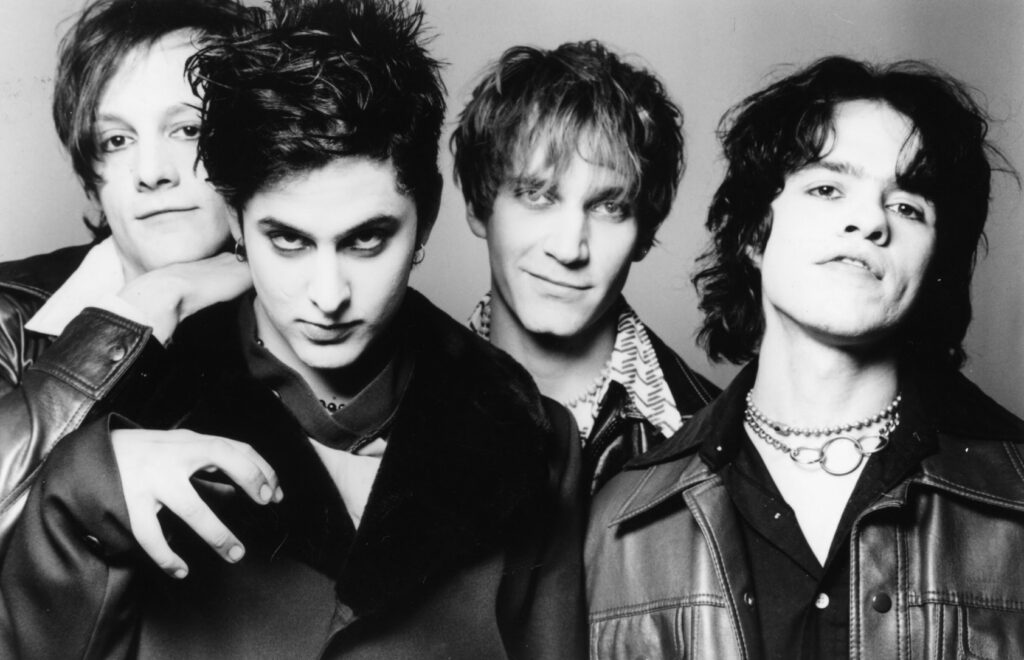“Were we cyberpunk?” asks Brainiac guitarist/vocalist John Schmersal, who, since 2023, has led his fellow bandmates on a series of tours to honour the music they made with frontman Timmy Taylor, who died in 1997. (They’ll be spending much of this month touring the US as guests of Mogwai.) Schmersal’s tongue is firmly in-cheek there: a hackneyed cliché like “cyberpunk” does not do justice to the wild, haywire wit and invention that coursed beneath Brainiac’s frenzied surface. But the group’s deployment of battered retro-futurist gear alongside their traditionalist guitar-drums-bass weaponry – not to mention their experimentation with electronica on later releases – identified them as outliers within an American underground scene that often seemed frightened of the future. Brainiac, by contrast, seemed poised to send US punk in an unlikely, visionary new direction, had cruel fate not stepped in and cut their story short.
Brainiac’s music was visceral, weird and inspired, and left you jolted like you’d just mainlined the National Grid. The Mars Volta’s Cedric Bixler-Zavala says his own creative process is governed by this simple Oblique Strategy: “What would Timmy Taylor do?” A gifted instrumentalist, singer and composer of offbeat, pop-soaked punk rock, Taylor liked nothing more than to run his songs and vocals through the avant garde mangle and revel in the misshapen mess that resulted. Brainiac’s debut, 1993’s Smack Bunny Baby, played things relatively straight, its darkly hilarious tales of hatred, alienation and self-annihilation Trojan-Horsed within noise-emboldened tuneage, fitting squarely within the post-Nevermind soundscape. But 1994’s Bonsai Superstar marked their quantum leap into the unknown. Taylor and new member Schmersal – who replaced OG guitarist Michelle Bodine – had become regulars at Dayton’s numerous thrift stores, buying up oddball vintage music tech that had been offloaded by the faded stars of the city’s now-dormant synth-funk explosion. They misused this out-of-fashion gear to mutate Brainiac’s early paradigm, delivering a Beefheartian odyssey of broken pop and ugly punk that blended wildly distorted vocals, maverick excursions into musique concrete and eerie, unsettling ballads sung over dying synthesisers.
As they drove home from New York’s Plantain Studios following the sessions with producer Eli Janney, the group were downcast, believing they’d created an unlistenable travesty; bassist Juan Monasterio “had this sinking feeling, like we’d just made the worst record of all time”. But Bonsai Superstar was a masterpiece that still sounds like nothing else before or since – drug metaphors might be the refuge of the rock-crit scoundrel, but Brainiac now sounded (brilliantly) like the Muppets pumped fulla the worst acid. The album got the group signed to venerated imprint Touch & Go Records, where they followed with 1996’s Hissing Prigs In Static Couture, which Schmersal describes as their “slick pop record” (relativity is doing a humongous amount of heavy lifting here), and a mini-LP recorded with Jim O’Rourke, 1997’s Electro Shock For President, that flirted with Aphex Twin-esque experimentalism and broke them further from the post punk pack.
Theirs was always an uncompromising sound, but Brainiac had champions within the mainstream firmament – Beck took them on tour, while Trent Reznor was a fan and, rumour has it, was interested in producing a mooted Brainiac album on his nothing label. But it wasn’t to be. Late one night in May 1997, Taylor crashed his vintage Mercedes into a lamppost; the coroner’s report later confirmed the singer was already dead of carbon monoxide poisoning when the accident occurred. Brainiac split immediately. But the group’s story wasn’t over: in 2019, a documentary, Transmissions After Zero, introduced Brainiac to a new audience, while several posthumous releases – The Attic Tapes, a compilation of Taylor demos; live album From Dayton Ohio; and Predator Nominate, an EP of unfinished sketches for where their fourth full-length might have taken them – followed. Meanwhile, the rejuvenated surviving band’s appetite to keep playing these savage, brilliant, darkly hilarious and wildly inspired songs remains unsated. Don’t miss them if you get the chance.
‘Get Away’ from Smack Bunny Baby (1993)
John Schmersal: Brainiac were like a neon version of Bad Brains – the music was faster than it ‘should’ be, and hairier than other things, and that’s what I always loved about it. They were like some crazy cartoon. I wasn’t in the band [when they made Smack Bunny Baby], but I’d played with Tyler [Trent, drummer] in high school, and knew Tim and Juan from their previous bands. I’d go see Brainiac play, and they were just fucking amazing. Like, ‘I like a band my friends are in! This is rare!’ This is a great pop song, one of their ‘straightest’ – it got played on the radio in Ohio all the time – but Tim had such a gift for warping and subverting things, even here. When I joined the band with the next record, I got to be part of that subversion; it was my ticket to ride.
‘Anesthetize’ from Smack Bunny Baby (1993)
JS: Timmy had learned drums and cello, played guitar in his dad’s jazz group, he even took voice lessons. But he was very shy about his vocals, even though he had a great voice. For him, using vocal effects was a way to hide, like putting on a mask. The lyrics are to ‘Anesthetize’ are dark, Kinksian, and the effects gave him further license to indulge in social commentary, turning his voice into another musical instrument, removing his inhibitions and allowing him to be outside of himself. The song was about alcohol – how people lead these ‘normal’ lives, but have to escape all the crazy stuff happening within them by getting drunk, and society says that that’s OK, because alcohol is this legal, normalised drug.
‘Hot Metal Doberman’s’ from Bonsai Superstar (1994)
JS: Tim grew more confident after I joined Brainiac: I understood the weird tuning thing, and had a bunch of weird tunings of my own, and it seemed to embolden him. We loved wild Japanese effects pedals – we didn’t like anything mellow, and were always like, ‘What happens when you when you turn the dial all the way up?’ ‘Hot Metal Doberman’s’ was the first track where he decided to layer several different vocal tracks over each other – he was like, ‘I can be three different characters in the same song!’ And it’s got a great opening line; it basically announces the troublesome presence of the album: ‘Whatcha gonna do about me?’
‘Fucking With The Altimeter’ from Bonsai Superstar (1994)
JS: It’s a song about a plane crashing, but it’s also about a relationship in crisis, and not knowing where it’s going. Tim would spend his nights in his Mom’s attic, making demos and fucking around. The demo for this was quite weird – hair-raising, scarier, but a good blueprint to show Eli [Janney, producer] what we wanted to do in the studio. Tim and I were getting into Tropicalia at the time, and the vocalisations at the beginning are totally Tom Ze: it’s almost beatboxing, creating a foundation for the song. On the chorus, Tim sang through a fan, like a Leslie speaker type, so it’s cutting up his voice. We loved trying all these experiments, and Eli was so great at being a shepherd, and making everything happen.
‘Collide’ from Bonsai Superstar (1994)
JS: The words Tim sings on ‘Collide’ are obscured on Bonsai Superstar – I think he realised how creepy and dark they were, and so he obliterated the entire thing and made it a symphony of distortion. There’s an earlier version of this on Attic Tapes [‘Oh Donna Collage’] where you can hear the words, and they’re probably not what you’d want to close a record with: ‘Oh, Donna/ We’ve got one more car to crash/ Oh, Donna/ Don’t retreat until the last/ Every bone you snap/ Draws the tension back/ Oh, Donna, collide’. We were all reading JG Ballard’s Crash at the time. Tim wrote a lot about car crashes. It’s very unnerving, in the context of his dying in a car crash. And in the days after he died, I would pore over lyrics like these, asking myself how he could die at the peak of our thing, when we were gonna go to our next chapter. Did he do this on purpose? But it was all just a coincidence: the cause of the crash was not his driving, he’d died of carbon monoxide poisoning. But we didn’t find that out until much later.
‘Indian Poker Pt 3’ from Hissing Prigs In Static Couture (1996)
JS: With Hissing Prigs, Eli wanted to find new ways to do the same thing that we kept asking to do over and over again: essentially, finding the right way to do the ‘wrong’ thing in the studio. Here, we discovered a different kind of distortion, by plugging our guitars directly into the board and blasting away. Eli put a limiter on it, completely frying out the signal for both of us, just to see what it sounded like. And it sounded great – absolutely like it’s seriously damaging your stereo. We weren’t really counting on the reaction friends had when they put on – they were like, ‘What the fuck? What happened? Turn it off!’ We thought we were just making a fresh sound. But Eli always understood our sensibility and what we were after, and always helped us find our way to that in the studio.
‘I Am A Cracked Machine’ from Hissing Prigs In Static Couture (1996)
JS: Tim had this ring modulator, but he had programmed it so he could tweak the pitches from the joystick on his controller. The sound it gave his voice inspired him to write about this ailing cyborg character, the ‘cracked machine’. I always thought this song was more unhinged live – it’s a bit reserved on the record. I feel like Hissing Prigs is our ‘pop’ album.
The line ‘Is planned obsolescence a fact?’ seems particularly resonant, since your music was often made on busted, outdated synths you’d picked up in pawn shops – obsolescent, cracked machines.
JS: We’d developed relationships with these shops, and often they’d bring us things that they found, knowing what we were looking for or liked working with. We really liked stuff that was maybe a bit broken. All these machines were really cheap. We were creating this narrative, I guess, using broken machinery to write about broken machinery. Were we cyberpunk?! [laughs]
‘For My Beloved’ from Electro-Shock For President (1997)
JS: I remember we were heavily into Aphex Twin back then. And we loved Gastr Del Sol, and really loved the US Maple records, so we thought Jim O’Rourke would be a great person to work with. We’d recorded a bunch of stuff on an eight track reel-to-reel that used to belong to Lenny Kravitz, and brought it to Jim to pull it all together. I remember Jim transferring ‘For My Beloved’ to the final mix, and telling us how much he loved Abba and the production on their records – not a direction I’d expected the conversation to go in [laughs] – and he just leaned over and swatted the reel-to-reel. You can hear it on the record – all of a sudden the track warps, like a cassette’s getting chewed up. Anyone else would be, ‘Why the fuck did you do that?’ But Tim and I just grinned at each other – we loved stuff like that. Jim was a great collaborator.
‘Mr. Fingers’ from Electro-Shock For President (1997)
JS: It’s about a character who obviously has some personal problems, who talks to his fingers; maybe he’s a predator of some kind. It was our first foray into using a sampler with a sequencer and doing very intense, very detailed stuff. And it’s a good marriage, because it’s a kind-of rock song, it’s really raw-sounding, but it has this underlying electronic aesthetic to it. People use the word genius very loosely, but Jim O’Rourke is the real deal. At the end, Jim was like, ‘Maybe we can work together again’. And we’d have loved to work on a whole record with him, rather than having him come in as a fixer, like he did here. But a lot of people say Electro-Shock For President is their favourite Brainiac record.
‘Predator Nominate’ from The Predator Nominate (2023)
The tracks on The Predator Nominate aren’t what Brainiac’s next album would have sounded like – they’re just demos, and really adjacent to Electro-Shock. It’s like a sister record, from the same palette. It has the vibe of Wax Trax, of Chicago industrial stuff, and I can see why Trent Reznor was attracted to what we were doing; Trent apparently referenced Electro-Shock as an influence while he was making Nine Inch Nails’ With Teeth. And have you ever seen the cover to Marilyn Manson’s Mechanical Animals? It looks like he’s tried to make himself look like the figure on the sleeve of Hissing Prigs, and spelled his name out with numbers and letters, like we did [Brainiac was styled “3ra1n1ac” on the sleeve of Hissing Prigs]. So we’d made some impression on that world.











